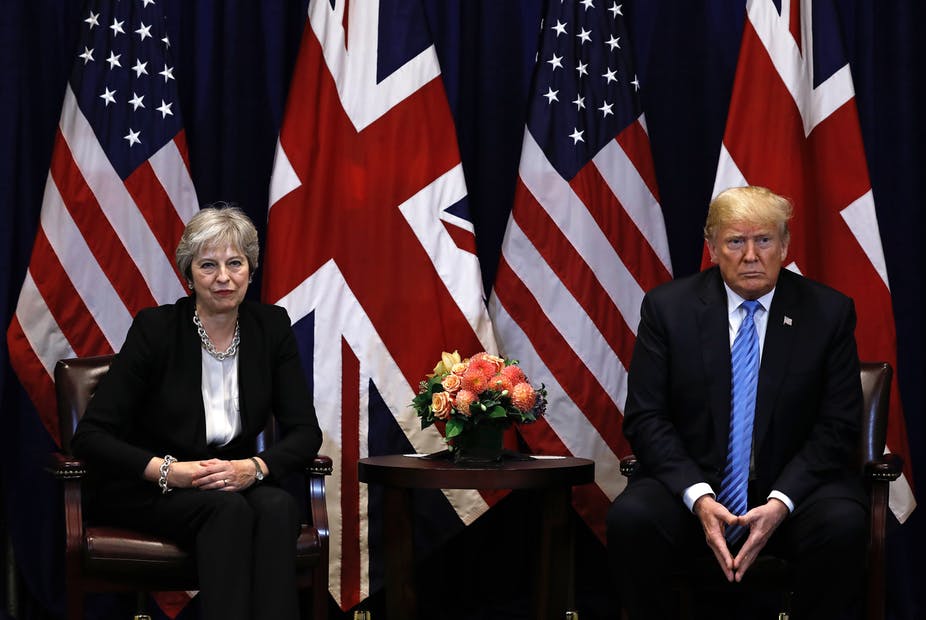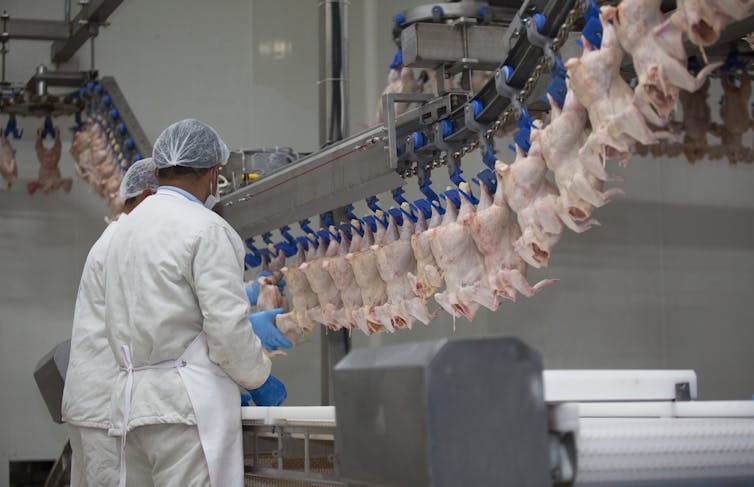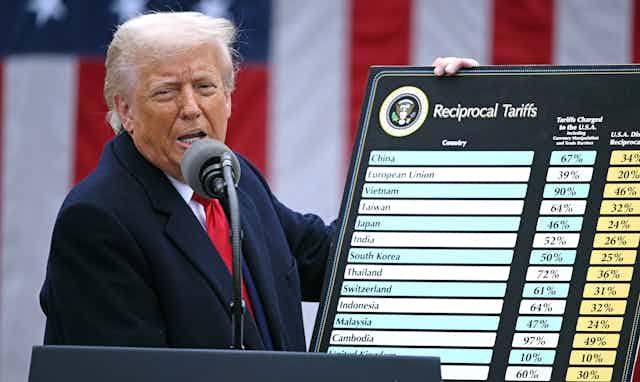
Leaving the EU only to be exploited by the US. EPA/Peter Foley
The US has published its objectives for a proposed trade agreement with the UK – and its thinking highlights just how weak Britain’s bargaining position will be in the post-Brexit global economy.
The US trade representative outlines many of the usual ways to increase trade between the two countries – namely, reducing tariffs and ensuring both sides share the same standards and regulations. But the emphasis is very much on the UK aligning itself with US standards. This will have major implications. It will move the UK away from the EU standards it currently has, which will harm trade with its most important trading partner and generate potential hurdles in a future trade deal with the EU.
The US is taking a tough line from the outset on a number of issues. With a population of 66m and GDP of roughly US$3 trillion, the UK is dwarfed by the bloc it is leaving – the EU’s population is 500m and has a combined GDP of US$20 trillion. Plus, the UK has a transparent need to both replace existing EU trade agreements and create new ones.
In Britain, concerns over food safety have been at the heart of debate over a potential US-UK trade agreement. The expectation of American chlorine-washed chicken entering British markets as part of a deal quickly became politically contentious, splitting Theresa May’s cabinet twice in 2017.
Read more:
Chlorine-washed chicken Q&A: food safety expert explains why US poultry is banned in the EU
But the quandary facing the British government extends well beyond concerns over the consumer safety implications of US mass production methods. With US agricultural imports would also come US agricultural and sanitary and phytosanitary standards, which are in place to protect against diseases. This will create hurdles for British agricultural exports heading to the EU, as it will no longer meet EU standards.
For British farmers, the wholesale removal of trade barriers with the US may also come at a time when the industry is particularly vulnerable. Following Brexit, British agriculture will lose access to the EU subsidies it receives through the Common Agricultural Policy. While the UK government has promised to replace these, questions about its ability to fund its many post-Brexit promises remain.
Beyond agriculture
British manufacturers face the same demands to harmonise their regulations from the US trade representative, creating similar difficulties for exporters targeting the EU. Then, when it comes to services, US demands are much more dramatic.
Britain’s service sector brings in a substantial trade surplus – something the US will be loath to add to its growing trade deficit. Central to US plans will be to privatise and deregulate British services, such as healthcare provision or utilities and infrastructure, to enable easy market access for internationally-engaged American enterprises. These same corporations are actively engaged in the trade agreement process on the US side.

Shutterstock
American ambitions for bringing UK regulations in line with its own also extends to trade of digital goods and services, potentially causing a tremendous shift away from EU regulations, which concern everything from intellectual property rights to data protection and digital privacy.
Beyond trade
As part of the deep integration objectives, the US-UK trade agreement will cover additional non-trade issues. These include labour standards, environmental protection and anti-corruption measures – all areas where the UK arguably is currently tougher than the US.
It is telling that the wording of the US objectives focuses explicitly on the UK obligations in upholding these kinds of standards. In contrast, US objectives for negotiations with Japan refer to both “parties”, rather than specifically Japanese obligations.
Perhaps the differences in wording is a result of different teams writing the documents. But it could also reveal the extent to which the UK is viewed by the US team as the weaker party to their deal, which will likely have extensive effects on the concessions the UK negotiating team can manage to extract from the US opening position.
Relinquishing control, not taking it back
Rather than taking back control, the starting point for US-UK trade negotiations is one where the British government cedes sovereignty over a wide range of issues. Britain’s size and detachment from the EU single market limits its bargaining power with large trade partners, whose governments will have no concern for the effects on the British public.
While harmonising standards with the US will pose a barrier to future trade with the EU, the deal could also increase limitations on British foreign policy more broadly. The US is also pursuing a clause that allows it to withdraw from a US-UK agreement if the UK agrees to an agreement with certain countries such as China. Similar terms are included in the US-Japan trade agreement objectives, as the Trump administration tries to limit China’s economic influence across the globe. There is also a section in the US objectives that is designed to limit Britain’s independence over its Middle East foreign policy.
The hard line taken by the US, along with the wide range of concessions demanded of the UK clearly point to the UK’s weakened bargaining position outside the EU. And the US is not the only trading partner seeking significant concessions in exchange for a deal. India, Japan, and South Korea have all signalled similar expectations in preparations for their own deals. All of this sits in stark contrast to the Brexit campaign’s promise to “take back control”.![]()
Michael Plouffe, Lecturer in International Political Economy, UCL
This article is republished from The Conversation under a Creative Commons license. Read the original article.




27 Comments
Pingback: demo slot pg
Pingback: Guns for sale
Pingback: พรมปูพื้นรถยนต์
Pingback: Cartel oil company
Pingback: รับติดตั้งระบบไฟฟ้า
Pingback: pakkumised ja teenused
Pingback: รับตกแต่งร้าน
Pingback: ต่อขนตา สีลม
Pingback: sexy girl
Pingback: .
Pingback: เว็บ บอล ไม่มี ขั้นต่ำ มีดียังไง?
Pingback: Food Recipe Video
Pingback: filler
Pingback: ปั่นสล็อต ด้วยสูตรอัพเดตใหม่
Pingback: cinemakick
Pingback: 50 tokens
Pingback: wing888
Pingback: โคมไฟ
Pingback: Daha fazla ayr脹nt脹
Pingback: เว็บปั้มไลค์
Pingback: Chicken Road
Pingback: hit789
Pingback: sixma32
Pingback: สับปะรด สล็อต ฝากถอนออโต้ ทรูวอเลท
Pingback: รีวิวเกมสล็อต ค่าย PG SLOT
Pingback: Kimberly
Pingback: สมัครเว็บตรงไม่ผ่านเอเย่นต์